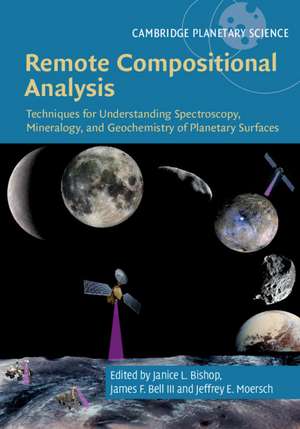Remote Compositional Analysis: Techniques for Understanding Spectroscopy, Mineralogy, and Geochemistry of Planetary Surfaces: Cambridge Planetary Science, cartea 24
Editat de Janice L. Bishop, James F. Bell III, Jeffrey E. Moerschen Limba Engleză Hardback – 27 noi 2019
Din seria Cambridge Planetary Science
-
 Preț: 401.87 lei
Preț: 401.87 lei - 9%
 Preț: 871.61 lei
Preț: 871.61 lei - 8%
 Preț: 521.69 lei
Preț: 521.69 lei - 11%
 Preț: 579.05 lei
Preț: 579.05 lei -
 Preț: 458.24 lei
Preț: 458.24 lei - 14%
 Preț: 716.10 lei
Preț: 716.10 lei -
 Preț: 446.28 lei
Preț: 446.28 lei - 11%
 Preț: 506.54 lei
Preț: 506.54 lei -
 Preț: 337.66 lei
Preț: 337.66 lei - 14%
 Preț: 941.54 lei
Preț: 941.54 lei - 11%
 Preț: 587.99 lei
Preț: 587.99 lei - 14%
 Preț: 1260.55 lei
Preț: 1260.55 lei - 23%
 Preț: 1135.29 lei
Preț: 1135.29 lei -
 Preț: 353.83 lei
Preț: 353.83 lei - 14%
 Preț: 1033.36 lei
Preț: 1033.36 lei - 14%
 Preț: 908.92 lei
Preț: 908.92 lei -
 Preț: 446.87 lei
Preț: 446.87 lei - 11%
 Preț: 597.23 lei
Preț: 597.23 lei -
 Preț: 400.70 lei
Preț: 400.70 lei -
 Preț: 357.51 lei
Preț: 357.51 lei -
 Preț: 350.76 lei
Preț: 350.76 lei - 14%
 Preț: 1056.97 lei
Preț: 1056.97 lei - 19%
 Preț: 734.95 lei
Preț: 734.95 lei - 23%
 Preț: 826.95 lei
Preț: 826.95 lei - 20%
 Preț: 474.96 lei
Preț: 474.96 lei
Preț: 751.63 lei
Preț vechi: 873.99 lei
-14% Nou
Puncte Express: 1127
Preț estimativ în valută:
143.84€ • 149.62$ • 118.75£
143.84€ • 149.62$ • 118.75£
Carte disponibilă
Livrare economică 24 martie-07 aprilie
Preluare comenzi: 021 569.72.76
Specificații
ISBN-13: 9781107186200
ISBN-10: 110718620X
Pagini: 652
Ilustrații: 32 b/w illus. 147 colour illus.
Dimensiuni: 177 x 257 x 35 mm
Greutate: 1.41 kg
Editura: Cambridge University Press
Colecția Cambridge University Press
Seria Cambridge Planetary Science
Locul publicării:New York, United States
ISBN-10: 110718620X
Pagini: 652
Ilustrații: 32 b/w illus. 147 colour illus.
Dimensiuni: 177 x 257 x 35 mm
Greutate: 1.41 kg
Editura: Cambridge University Press
Colecția Cambridge University Press
Seria Cambridge Planetary Science
Locul publicării:New York, United States
Cuprins
Part I. Theory of Remote Compositional Analysis Techniques and Laboratory Measurements: 1. Electronic spectra of minerals in the visible and near-infrared regions; 2. Theory of reflectance and emittance spectroscopy of geologic materials in the visible and infrared regions; 3. Mid-IR (thermal) emission and reflectance spectroscopy: laboratory spectra of geologic materials; 4. Visible and near-infrared reflectance spectroscopy: laboratory spectra of geologic materials; 5. Visible and infrared spectroscopy of ices, volatiles and organics; 6. Raman spectroscopy: theory and laboratory spectra of geologic materials; 7. Mössbauer spectroscopy: theory and laboratory spectra of geologic materials; 8. Laser-induced breakdown spectroscopy: theory and laboratory spectra of geologic materials; 9. Fundamentals of neutron, X-ray and gamma ray spectroscopy; 10. Radar remote sensing: theory and applications; Part II. Terrestrial Field and Airborne Applications: 11. Visible and near-infrared reflectance spectroscopy: field and airborne measurements; 12. Raman spectroscopy: field measurements; Part III. Analysis Methods: 13. Effects of environmental conditions on spectral measurements; 14. Hyper- and multispectral VNIR imaging analysis; 15. Thermal infrared spectral modeling; 16. Geochemical interpretations using multiple remote datasets; Part IV. Applications to Planetary Surfaces: 17. Spectral analyses of Mercury; 18. Compositional analysis of the Moon from the visible and near-infrared; 19. Spectral analyses of asteroids; 20. VIS-NIR spectral analyses of asteroids and comets from Dawn and Rosetta; 21. Spectral analyses of Saturn's moons using Cassini-VIMS; 22. Spectroscopy of Pluto and its satellites; 23. VSWIR spectral analyses of Mars from orbit using CRISM and OMEGA; 24. Thermal infrared spectral analyses of Mars from orbit using TES and THEMIS; 25. Rover-based thermal infrared remote sensing of Mars using the mini-TES instrument; 26. Compositional and mineralogic analyses of Mars using multispectral imaging on the Mars Exploration Rover, Phoenix, and Mars Science Laboratory Missions; 27. Iron mineralogy, oxidation state, and alteration on Mars from Mössbauer spectroscopy at Gusev Crater and Meridiani Planum; 28. Elemental analyses of Mars using APXS; 29. Elemental analyses of Mars with LIBS by ChemCam and SuperCam; 30. X-ray, gamma-ray, and neutron spectroscopy: planetary missions; 31. Radar remote sensing of planetary bodies.
Recenzii
'… provides a thoroughly updated entry point to the field, covering the techniques used on missions from Mercury to Pluto and almost everywhere in between … Researchers will appreciate the copious end-of-chapter references (chapter 3 alone provides 132 citations). Though the density of information may be intimidating to novices, libraries supporting graduate astronomy programs should certainly acquire this book.' S. G. Decker, Choice
Descriere
Comprehensive overview of the spectroscopic, mineralogical, and geochemical techniques used in planetary remote sensing.
